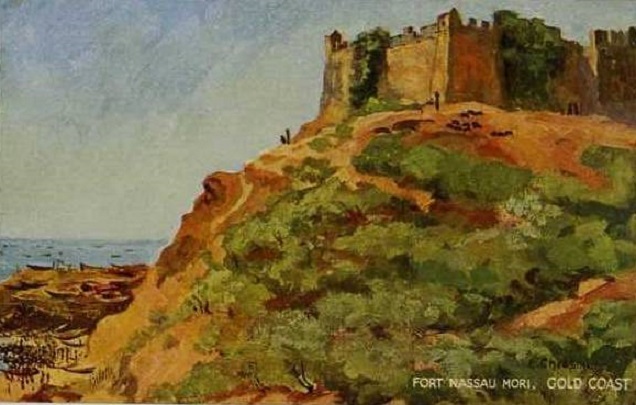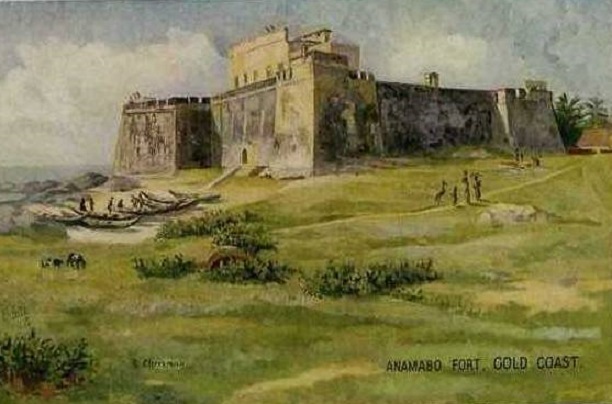Fort Amsterdam – The Overlooked Gem on the Hills of Abandze
The first time I visited a historical site in Ghana, it was the hauntingly powerful Cape Coast Castle. That experience opened my eyes to a painful past, the suffering endured by our ancestors, and the resilience that still lives in us today. On one of my many return trips to Cape Coast, curiosity got the better of me. I’d always noticed a striking old fort in the distance whenever I passed through Abandze. That day, I decided to stop.

Fort Nassau
Climbing up the gentle hill where Fort Amsterdam stands was like stepping into a different world. Though smaller and quieter than its more famous counterparts, the fort immediately commanded my attention. Weathered by time but still standing strong, its presence was both beautiful and solemn.
A local tour guide welcomed me warmly, and we dove into a journey through time. He shared stories about the fort’s origins, its colonial significance, and the dark moments that echoed through its dungeons and walls — moments that connect us all to a part of history we must never forget. It was a moving experience, made even more powerful by the peaceful sea breeze and panoramic view that surrounded us.

Fort Anamabo
What struck me most was how such a significant historical site remains overlooked by many locals and tourists alike. Ghana’s coast is dotted with castles and forts, each with a unique story to tell. Fort Amsterdam is one of those hidden gems that deserve more attention, not just for its historical weight, but for its quiet beauty and the serenity it offers.
So next time you're heading to Cape Coast or Elmina, make a stop at Abandze. Climb the hill, stand where history was made, and take in the view. Fort Amsterdam may not be the loudest voice in Ghana’s historical narrative, but it speaks volumes — if you take the time to listen.
Fort Amsterdam: Historical Context & Overview
1. Colonial Background
European Construction: Fort Amsterdam was one of several forts built by European powers—particularly the Dutch—along Ghana’s coast in the 17th century to support trade, including the tragic slave trade.
Strategic Location: Positioned on a hill in Abandze, the fort was likely built to secure access to nearby rivers or protect shipping lanes—common strategic considerations of the time.
2. Approximate Timeline
Late 1600s Era: Most coastal forts established by the Dutch, such as Fort Amsterdam, were constructed in this period (around the 1630s–1660s), during intense European competition for coastal dominance.
3. Purpose and Role
Trade Hub: Like other forts on the coast—Cape Coast, Elmina, Fort Nassau—it functioned as a trading post for gold, ivory, and unfortunately, human beings.
Military and Administrative Center: It also likely served as a military outpost and logistics base for controlling the surrounding area and river traffic.
4. Changing Hands
The control of Fort Amsterdam may have changed between the Dutch, British, or other colonial powers through treaty, conflict, or sale, as happened with many Ghanaian forts.
5. Post-Colonial Era
Historic Relic: After the abolition of the transatlantic slave trade and eventual independence of Ghana, Fort Amsterdam became part of the nation’s colonial heritage. Unlike Elmina or Cape Coast, it remains less visited and lesser-known, making it a hidden gem.
Why the Definitive History Is Hard to Find
Limited Documentation: Smaller or less prominent forts like Fort Amsterdam often lack detailed historical records compared to Cape Coast or Elmina.
Oral History: Local stories and traditions often preserve the fort’s memory more than written archives. Visiting the site and engaging with local guides can uncover unique narratives.
Suggested Next Steps for Historical Clarity:
If you're seeking more accuracy or buried stories, consider:
Visiting Local Archives: Ghana’s National Archives (especially at Cape Coast or Accra) may hold colonial maps, traders’ logs, or records on minor forts.
Contacting Heritage Experts: Institutions like the Ghana Museums and Monuments Board (GMMB) or academic historians might provide documented insight.
Exploring Oral Narratives: Speaking directly to local elders in Abandze or tour guides can often uncover valuable anecdotal history.
Summary
While detailed, verified records for Fort Amsterdam in Abandze are scarce online, it remains a significant example of Ghana’s layered colonial past—built by the Dutch, used for trade, and now quietly standing as a memory of history. It's worth exploring through more dedicated historical channels or local knowledge.